Oracle数据库性能优化
oracle优化方法总结
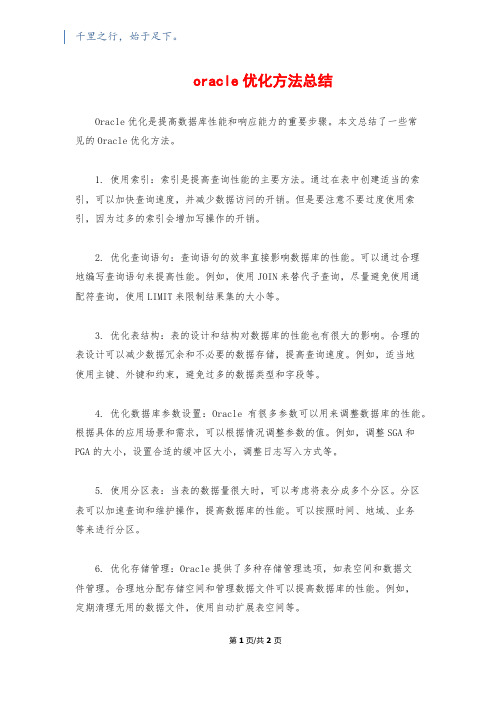
千里之行,始于足下。
oracle优化方法总结Oracle优化是提高数据库性能和响应能力的重要步骤。
本文总结了一些常见的Oracle优化方法。
1. 使用索引:索引是提高查询性能的主要方法。
通过在表中创建适当的索引,可以加快查询速度,并减少数据访问的开销。
但是要注意不要过度使用索引,因为过多的索引会增加写操作的开销。
2. 优化查询语句:查询语句的效率直接影响数据库的性能。
可以通过合理地编写查询语句来提高性能。
例如,使用JOIN来替代子查询,尽量避免使用通配符查询,使用LIMIT来限制结果集的大小等。
3. 优化表结构:表的设计和结构对数据库的性能也有很大的影响。
合理的表设计可以减少数据冗余和不必要的数据存储,提高查询速度。
例如,适当地使用主键、外键和约束,避免过多的数据类型和字段等。
4. 优化数据库参数设置:Oracle有很多参数可以用来调整数据库的性能。
根据具体的应用场景和需求,可以根据情况调整参数的值。
例如,调整SGA和PGA的大小,设置合适的缓冲区大小,调整日志写入方式等。
5. 使用分区表:当表的数据量很大时,可以考虑将表分成多个分区。
分区表可以加速查询和维护操作,提高数据库的性能。
可以按照时间、地域、业务等来进行分区。
6. 优化存储管理:Oracle提供了多种存储管理选项,如表空间和数据文件管理。
合理地分配存储空间和管理数据文件可以提高数据库的性能。
例如,定期清理无用的数据文件,使用自动扩展表空间等。
第1页/共2页锲而不舍,金石可镂。
7. 数据压缩:对于大量重复数据或者冷数据,可以考虑使用Oracle的数据压缩功能。
数据压缩可以减少磁盘空间的使用,提高IO性能。
8. 使用并行处理:对于大型计算或者批处理任务,可以考虑使用Oracle的并行处理功能。
并行处理可以将任务分成多个子任务,并行执行,提高处理能力和效率。
9. 数据库分区:对于大型数据库,可以考虑将数据库分成多个独立的分区。
数据库分区可以提高数据的并行处理能力,减少锁竞争和冲突,提高数据库的性能。
ORACLE数据库性能优化

(三)(三)优化 I/O 操作 I/O 优化被安排在内存优化之后,通过内存的优化,可以是 I/O 冲突减少,在此情况下, 可以通过一些调整以使 I/O 性能进一步提高。 对于新系统,应自顶向下分析 I/O 需求,确定所需要的资源。而对于已存在的系统应采 用自底向上的方法: 1.1.了解系统的磁盘数量。 2.2.了解 ORACLE 使用的磁盘数量。 3.3.了解应用系统的 I/O 类型。 4.4.了解 I/O 操作是针对文件系统还是原始设备。 5.5.了解对象在磁盘上的分布。 可以通过如下方法检查 I/O 问题: 检查系统 I/O 的使用:可以使用操作系统提供的工具来监视整个系统对磁盘 文件的访问,可以将大量访问磁盘的应用与 ORACLE 的相关文件分别存放。在 UNIX 系统中可以通过 sar –d 来获得有关数据。在 WINDOWS NT 中 可 通 过 性 能监视器查看。 检查 ORACLE 的 I/O 的使用:对于 ORACLE ,可以通过下列视图来获得相 关的信息: File Type Where to Find Statistics Database Files V$FILESTAT Log Files V$SYSSTAT, V$SYSTEM_EVENT, V$SESSION_EVENT Archive Files V$SYSTEM_EVENT, V$SESSION_EVENT Control Files V$SYSTEM_EVENT, V$SESSION_EVENT 可以通过如下的方法来解决 I/O 问题: 减少磁盘竞争: 磁盘竞争:当多个进程同时访问同一个磁盘时就会产生磁盘竞争。要减 少高负荷磁盘的访问,可以将高访问量的文件移到低负荷的磁盘上。 分离 Redo 日志文件和数据文件:ORACLE 总是经常的访问 Redo 日志 文件和数据文件,将二者放在一起,可能会增加磁盘冲突。 条带化表数据:条带化,就是将一个大表的数据分布到不同磁盘的不同 数据文件中,这样也可以减少磁盘冲突。 分离表和索引:这并不是必须的,由于索引和表的读取是串行的,也可 以做到将表和索引放在一起而不发生磁盘冲突。 磁盘条带化:就是将一个大表的数据分布到不同磁盘的不同数据文件中,条 带化允许不同的进程同时访问一个表的不同部分。 这尤其对随机访问一个表的多行 很有帮助。条带化可以是磁盘的 I/O 负载平衡。有两种条带化方法。 手动方法:利用表空间以及分区表的方式。
Oracle数据库参数优化
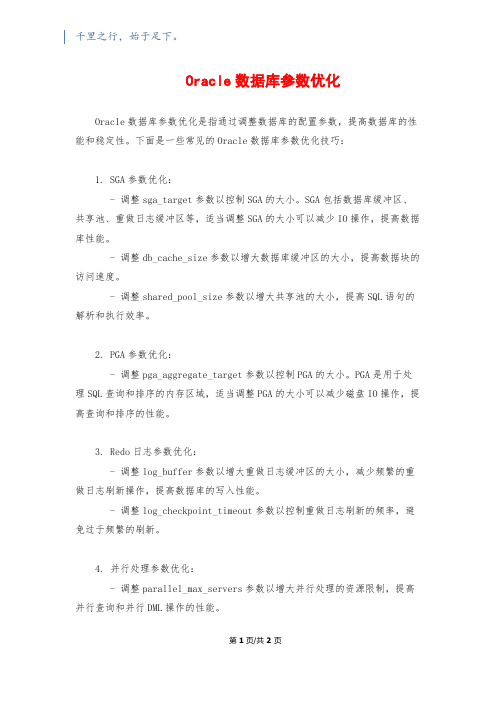
千里之行,始于足下。
Oracle数据库参数优化Oracle数据库参数优化是指通过调整数据库的配置参数,提高数据库的性能和稳定性。
下面是一些常见的Oracle数据库参数优化技巧:1. SGA参数优化:- 调整sga_target参数以控制SGA的大小。
SGA包括数据库缓冲区、共享池、重做日志缓冲区等,适当调整SGA的大小可以减少IO操作,提高数据库性能。
- 调整db_cache_size参数以增大数据库缓冲区的大小,提高数据块的访问速度。
- 调整shared_pool_size参数以增大共享池的大小,提高SQL语句的解析和执行效率。
2. PGA参数优化:- 调整pga_aggregate_target参数以控制PGA的大小。
PGA是用于处理SQL查询和排序的内存区域,适当调整PGA的大小可以减少磁盘IO操作,提高查询和排序的性能。
3. Redo日志参数优化:- 调整log_buffer参数以增大重做日志缓冲区的大小,减少频繁的重做日志刷新操作,提高数据库的写入性能。
- 调整log_checkpoint_timeout参数以控制重做日志刷新的频率,避免过于频繁的刷新。
4. 并行处理参数优化:- 调整parallel_max_servers参数以增大并行处理的资源限制,提高并行查询和并行DML操作的性能。
第1页/共2页锲而不舍,金石可镂。
- 调整parallel_min_servers参数以设置最小的并行处理资源数,避免并行操作的启动延迟。
5. SQL优化:- 使用合适的索引和优化的SQL语句,优化查询的执行计划。
- 使用绑定变量而不是直接将参数传递到SQL语句中,避免SQL重解析,提高性能。
6. 服务器参数优化:- 调整processes参数以增加数据库的并发连接数。
- 调整sessions参数以控制数据库的最大会话数。
- 调整open_cursors参数以增大打开游标的数量,避免游标溢出。
以上是一些常见的Oracle数据库参数优化技巧,但具体的优化策略需要根据实际情况进行调整,可以参考Oracle官方文档和专业的DBA建议。
Oracle的性能优化

千里之行,始于足下。
Oracle的性能优化Oracle数据库性能优化是提高数据库性能的关键步骤之一。
通过对数据库的优化,可以提高查询速度、降低系统负载、提升系统稳定性,从而提高用户的体验。
下面将介绍一些常见的Oracle数据库性能优化策略。
1. 索引优化:索引是提高查询效率的重要手段,可以极大地减少查询时的磁盘I/O操作。
优化索引包括以下几个方面:- 选择合适的索引类型,如B树索引、位图索引等。
根据具体业务场景选择适当的索引类型。
- 考虑创建复合索引,将多个列放在同一个索引内,可以减少索引的数量,提高查询效率。
- 避免创建过多的索引,过多的索引会增大数据插入和更新的成本。
- 定时对索引进行统计信息收集,使优化器能够更好地选择索引执行计划。
2. 查询优化:- 避免使用SELECT *查询,只查询需要的列,减少数据传输量。
- 使用合理的JOIN语句,避免嵌套循环连接或者全表扫描。
- 使用EXISTS或IN替代NOT EXISTS或NOT IN,后者在数据量大时性能较差。
- 避免使用函数或者表达式作为WHERE条件,这会导致索引失效。
- 使用分页查询时,尽量使用ROWNUM而不是OFFSET/FETCH,后者性能较差。
3. 表结构优化:- 合理设计表结构,尽量避免冗余数据和重复字段。
- 使用正确的数据类型,减少存储空间的浪费。
第1页/共3页锲而不舍,金石可镂。
- 选择合适的表空间和存储策略,避免表空间的碎片化和数据文件的扩展问题。
- 定期清理无用数据,避免数据库膨胀过快。
4. 系统参数优化:- 调整SGA参数和PGA参数的大小,根据实际情况合理分配内存。
- 调整日志参数,如redo日志大小和checkpoint间隔,减少写入磁盘的次数。
- 调整并发参数,如并行度和数据库连接数,提高系统的并发性能。
5. 存储优化:- 使用合理的存储结构,如表空间、数据文件、表和索引的分布策略。
- 使用合适的存储介质,如固态硬盘(SSD)、闪存阵列等,提高存储性能。
oracle性能优化面试题
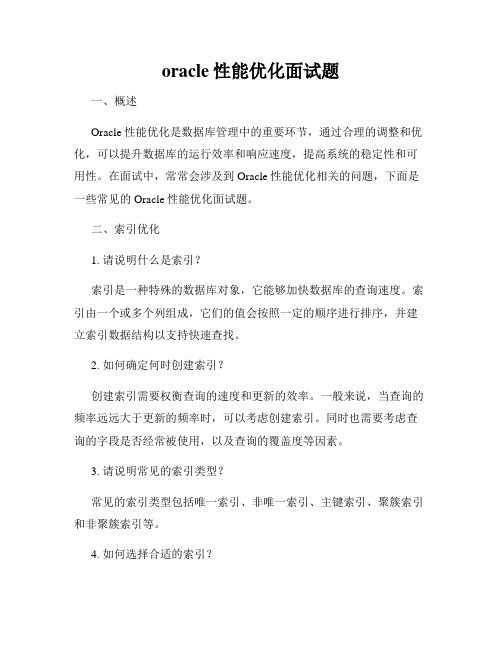
oracle性能优化面试题一、概述Oracle性能优化是数据库管理中的重要环节,通过合理的调整和优化,可以提升数据库的运行效率和响应速度,提高系统的稳定性和可用性。
在面试中,常常会涉及到Oracle性能优化相关的问题,下面是一些常见的Oracle性能优化面试题。
二、索引优化1. 请说明什么是索引?索引是一种特殊的数据库对象,它能够加快数据库的查询速度。
索引由一个或多个列组成,它们的值会按照一定的顺序进行排序,并建立索引数据结构以支持快速查找。
2. 如何确定何时创建索引?创建索引需要权衡查询的速度和更新的效率。
一般来说,当查询的频率远远大于更新的频率时,可以考虑创建索引。
同时也需要考虑查询的字段是否经常被使用,以及查询的覆盖度等因素。
3. 请说明常见的索引类型?常见的索引类型包括唯一索引、非唯一索引、主键索引、聚簇索引和非聚簇索引等。
4. 如何选择合适的索引?选择合适的索引需要考虑查询的频率、更新的频率、查询的覆盖度等因素。
同时还需要考虑索引的大小以及对于查询的影响。
三、SQL优化1. 请说明常见的SQL调优手段?常见的SQL调优手段包括使用合适的索引、优化SQL语句的写法、使用合适的连接方式、减少数据库的访问次数等。
2. 如何使用执行计划进行SQL优化?执行计划是Oracle数据库为了优化查询语句而生成的查询执行计划,其中包含了查询的操作步骤、连接方式、访问路径等信息。
可以通过查看执行计划来判断查询是否需要进行优化,并通过优化查询的方式来提升性能。
3. 如何优化大表查询?优化大表查询可以通过分页查询、增加条件过滤、创建合适的索引等方式来进行。
同时也可以考虑对大表进行分区或者分表的方式来提高查询效率。
四、资源优化1. 如何优化内存资源?优化内存资源可以通过调整SGA和PGA的大小来实现。
SGA包括共享池、数据库缓存和重做日志缓冲等,可以通过调整参数来合理分配内存。
PGA是为每个会话分配的私有内存区域,可以通过调整PGA_AGGREGATE_TARGET参数来优化。
34种Oracle性能优化的方法

34种Oracle性能优化的方法1、选择最有效率的表名顺序(只在基于规则的优化器中有效):ORACLE的解析器按照从右到左的顺序处理FROM子句中的表名,FROM子句中写在最后的表(基础表driving table)将被最先处理,在FROM子句中包含多个表的情况下,你必须选择记录条数最少的表作为基础表。
如果有3个以上的表连接查询, 那就需要选择交叉表(intersection table)作为基础表, 交叉表是指那个被其他表所引用的表.2、WHERE子句中的连接顺序:ORACLE采用自下而上的顺序解析WHERE子句,根据这个原理,表之间的连接必须写在其他WHERE条件之前, 那些可以过滤掉最大数量记录的条件必须写在WHERE子句的末尾.3、SELECT子句中避免使用‘ * ‘:ORACLE在解析的过程中, 会将'*' 依次转换成所有的列名, 这个工作是通过查询数据字典完成的, 这意味着将耗费更多的时间4、减少访问数据库的次数:ORACLE在内部执行了许多工作: 解析SQL语句, 估算索引的利用率, 绑定变量 , 读数据块等;5、在SQL*Plus , SQL*Forms和Pro*C中重新设置ARRAYSIZE 参数, 可以增加每次数据库访问的检索数据量 ,建议值为2006、使用DECODE函数来减少处理时间:使用DECODE函数可以避免重复扫描相同记录或重复连接相同的表.7、整合简单,无关联的数据库访问:如果你有几个简单的数据库查询语句,你可以把它们整合到一个查询中(即使它们之间没有关系)8、删除重复记录:最高效的删除重复记录方法 ( 因为使用了ROWID)例子:DELETE FROM EMP E WHERE E.ROWID > (SELECT MIN(X.ROWID)FROM EMP X WHERE X.EMP_NO = E.EMP_NO);9、用TRUNCATE替代DELETE:当删除表中的记录时,在通常情况下, 回滚段(rollback segments ) 用来存放可以被恢复的信息. 如果你没有COMMIT事务,ORACLE会将数据恢复到删除之前的状态(准确地说是恢复到执行删除命令之前的状况) 而当运用TRUNCATE时, 回滚段不再存放任何可被恢复的信息.当命令运行后,数据不能被恢复.因此很少的资源被调用,执行时间也会很短. (译者按: TRUNCATE只在删除全表适用,TRUNCATE是DDL不是DML)10、尽量多使用COMMIT:只要有可能,在程序中尽量多使用COMMIT, 这样程序的性能得到提高,需求也会因为COMMIT所释放的资源而减少:COMMIT所释放的资源:a. 回滚段上用于恢复数据的信息.b. 被程序语句获得的锁c. redo log buffer 中的空间d. ORACLE为管理上述3种资源中的内部花费11、用Where子句替换HAVING子句:避免使用HAVING子句, HAVING 只会在检索出所有记录之后才对结果集进行过滤. 这个处理需要排序,总计等操作. 如果能通过WHERE子句限制记录的数目,那就能减少这方面的开销. (非oracle中)on、where、having这三个都可以加条件的子句中,on是最先执行,where次之,having最后,因为on是先把不符合条件的记录过滤后才进行统计,它就可以减少中间运算要处理的数据,按理说应该速度是最快的,where也应该比having快点的,因为它过滤数据后才进行sum,在两个表联接时才用on的,所以在一个表的时候,就剩下where跟having比较了。
Oracle数据库性能优化分析
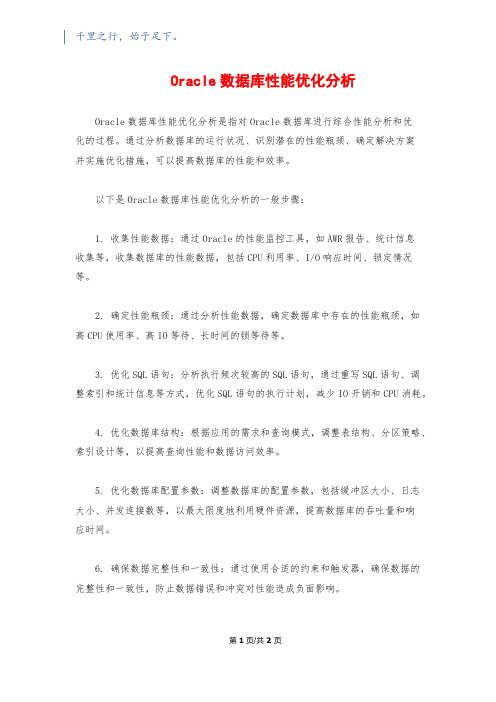
千里之行,始于足下。
Oracle数据库性能优化分析Oracle数据库性能优化分析是指对Oracle数据库进行综合性能分析和优化的过程。
通过分析数据库的运行状况、识别潜在的性能瓶颈、确定解决方案并实施优化措施,可以提高数据库的性能和效率。
以下是Oracle数据库性能优化分析的一般步骤:1. 收集性能数据:通过Oracle的性能监控工具,如AWR报告、统计信息收集等,收集数据库的性能数据,包括CPU利用率、I/O响应时间、锁定情况等。
2. 确定性能瓶颈:通过分析性能数据,确定数据库中存在的性能瓶颈,如高CPU使用率、高IO等待、长时间的锁等待等。
3. 优化SQL语句:分析执行频次较高的SQL语句,通过重写SQL语句、调整索引和统计信息等方式,优化SQL语句的执行计划,减少IO开销和CPU消耗。
4. 优化数据库结构:根据应用的需求和查询模式,调整表结构、分区策略、索引设计等,以提高查询性能和数据访问效率。
5. 优化数据库配置参数:调整数据库的配置参数,包括缓冲区大小、日志大小、并发连接数等,以最大限度地利用硬件资源,提高数据库的吞吐量和响应时间。
6. 确保数据完整性和一致性:通过使用合适的约束和触发器,确保数据的完整性和一致性,防止数据错误和冲突对性能造成负面影响。
第1页/共2页锲而不舍,金石可镂。
7. 监控和调优:定期监控数据库的性能指标,如响应时间、吞吐量等,及时识别和解决潜在的性能问题,保持数据库的高可用性和性能稳定性。
需要注意的是,性能优化是一个综合性的工作,需要结合具体的应用场景和需求来进行分析和优化,没有一种通用的解决方案,需要根据实际情况进行定制化的优化措施。
同时,性能优化是一个持续改进的过程,需要定期评估数据库的性能状况,并根据需求进行调整和优化。
常见Oracle数据库优化策略与方法
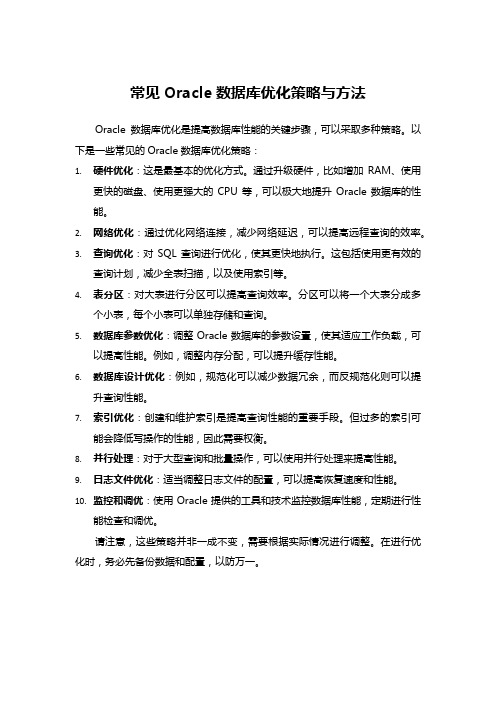
常见Oracle数据库优化策略与方法
Oracle数据库优化是提高数据库性能的关键步骤,可以采取多种策略。
以下是一些常见的Oracle数据库优化策略:
1.硬件优化:这是最基本的优化方式。
通过升级硬件,比如增加RAM、使用
更快的磁盘、使用更强大的CPU等,可以极大地提升Oracle数据库的性能。
2.网络优化:通过优化网络连接,减少网络延迟,可以提高远程查询的效率。
3.查询优化:对SQL查询进行优化,使其更快地执行。
这包括使用更有效的
查询计划,减少全表扫描,以及使用索引等。
4.表分区:对大表进行分区可以提高查询效率。
分区可以将一个大表分成多
个小表,每个小表可以单独存储和查询。
5.数据库参数优化:调整Oracle数据库的参数设置,使其适应工作负载,可
以提高性能。
例如,调整内存分配,可以提升缓存性能。
6.数据库设计优化:例如,规范化可以减少数据冗余,而反规范化则可以提
升查询性能。
7.索引优化:创建和维护索引是提高查询性能的重要手段。
但过多的索引可
能会降低写操作的性能,因此需要权衡。
8.并行处理:对于大型查询和批量操作,可以使用并行处理来提高性能。
9.日志文件优化:适当调整日志文件的配置,可以提高恢复速度和性能。
10.监控和调优:使用Oracle提供的工具和技术监控数据库性能,定期进行性
能检查和调优。
请注意,这些策略并非一成不变,需要根据实际情况进行调整。
在进行优化时,务必先备份数据和配置,以防万一。
- 1、下载文档前请自行甄别文档内容的完整性,平台不提供额外的编辑、内容补充、找答案等附加服务。
- 2、"仅部分预览"的文档,不可在线预览部分如存在完整性等问题,可反馈申请退款(可完整预览的文档不适用该条件!)。
- 3、如文档侵犯您的权益,请联系客服反馈,我们会尽快为您处理(人工客服工作时间:9:00-18:30)。
例子3——优化前
select b.insuredname, b.insuredidno
from llclaimpedor a, lccont b where trim(a.contno) = trim(b.contno)
and a.caseno = '9055000006018488'
例子3——优化后
例子4——优化后
SELECT r.* FROM LOPRTManager r, LCCont t WHERE r.StateFlag in ('1') and (patchflag is null or patchflag <> '1') and r.Code <> '70' AND r.PrtType = '0' and t.ContNo = r.OtherNo and r.ManageCom like '86070101%' union all SELECT r.* FROM LOPRTManager r WHERE r.StateFlag in ('1') and (patchflag is null or patchflag <> '1') and r.ManageCom like '86070101%' AND r.PrtType = '0' and r.Code = '70' and r.PrtSeq = '1019010000132388' and r.PrtSeq = '1019010000132388'
索引创建原则
提高查询语句的效率,减慢了DML语句的速度 在全表扫描和索引之间权衡 在哪些列建立索引 Where字句中引用的列 Join中引用的列 在子表的FK上建立索引 • 防止对父表操作时锁住子表 在哪些列上不要建立索引 经常有DML操作 排它性小 Select count(1),count(distinct col_name ) from table_name
Result
Execution Plan
Row Source GeneratorBiblioteka execute执行计划
RBO和CBO
优化器决定SQL语句的执行路径,对性能至关重要。 基于规则的优化器 RBO (Rule Based Optimizer) • No change since oracle 7.3,desupported in oracle 10 • Stable, generate the execution plan according to fixed rules • Not necessary good • Do not support new oracle features(like IOT, partition, materialized view,…) 基于成本的优化器 CBO (Cost based optimizer) • Since oracle 7.3 • Support all oracle features • Better than RBO in most case, Can be bad in some case • Choose the best execution plan according to internal algorithm • Need to analyze schema to get the best execution plan
• 80/20原则
Enqueue activity for DB rollback segment stats for DB rollback segment storage for DB Undo Segment Stats for DB latch activity for DB dictionary Cache stats for DB SGA memory summary for DB init.ora parameters for DB
单独表空间(>90M) 设置参数timed_statistics=true • 在init<sid>.ora中设置该参数,并让其生效 • SQL>alter system set timed_statistics=true;
STATSPACK的安装
SQL> @?/rdbms/admin/spcreate.sql; 脚本将自动创建PERFSTAT用户,并提示保存 STATSPACK统计信息的表空间以及临时表空间
Oracle操作优先级
RBO Path 1: Single Row by Rowid(等级最高) RBO Path 2: Single Row by Cluster Join RBO Path 3: Single Row by Hash Cluster Key with Unique or Primary Key RBO Path 4: Single Row by Unique or Primary Key RBO Path 5: Clustered Join RBO Path 6: Hash Cluster Key RBO Path 7: Indexed Cluster Key RBO Path 8: Composite Index RBO Path 9: Single-Column Indexes RBO Path 10: Bounded Range Search on Indexed Columns RBO Path 11: Unbounded Range Search on Indexed Columns RBO Path 12: Sort Merge Join RBO Path 13: MAX or MIN of Indexed Column RBO Path 14: ORDER BY on Indexed Column RBO Path 15: Full Table Scan(等级最低) 14
STATSPACK报告
性能快照的采集
SQL>exec statspack.snap;
统计报告的生成
SQL> @?/rdbms/admin/spreport.sql;
性能快照的自动采集
SQL> @?/rdbms/admin/spauto.sql;
AWR报告
报告中关注哪些内容
Top 5 timed events
SQL书写原则
同样的SQL只写一次。 使用表的别名,降低解析时间。 SELECT子句中避免使用 ‘ * ‘ 减少访问数据库的次数 用Where子句替换HAVING子句 尽量多使用COMMIT 用>=替代> 用Union all代替union 尽量用EXISTS替代IN、用NOT EXISTS替代NOT IN 用EXISTS替换DISTINCT
系统设计人员 程序开发人员 数据库管理员 系统管理员
有哪些限制?
数据库优化总体原则
技术
逻辑 正确 实践 第一 把握 重点 让用 户参 与
沟通
简化 业务 逻辑 持续 改进
优化一般过程
定位问题
发现问题
提出优化 方案
跟踪实际 应用
验证优化 方案
STATSPACK报告
安装Statspack的准备
——数据库调优专题培训
2011年09月
培训目标
通过本次培训你将了解
• 数据库优化基本原则 • Oracle性能诊断工具的使用 • SQL优化主要手段及原则 • 数据库设计原则及其重要性
也很重要但本次不涉及
• 第三方优化工具的使用 • 数据库参数调优 • ……
2
数据库优化总体原则
为什么要优化? 优化的范围? 谁来优化?
Instance efficiency Top SQL
Cache size – Load profile – Instance efficiency Percentages • 数据库主要都在干什么– Top timed event Top SQL – Instance Activity statistic tablespace IO stats for – DB – • 内存命中率DB file IO stats for buffer pool statistics for – DB PGA Aggr Target Stats – for DB
SQL书写原则
少用in、Or关键词 避免在索引列上进行计算 在条件上多加引号,避免改变数据类型 避免在索引列上使用IS NULL和IS NOT NULL 使用复合索引的第一个列进行查询 在索引列上慎用LIKE字句 在存储过程中慎用打开超过一万行数据的游标 优先使用INT而不是Varchar2 优先使用Varchar2,而不是CHAR。 避免不必要的排序:distinct、order by
例子2——优化后
Select * from v_bc_lcinsured i, LLSubReport t, LLReportRela a where i.insuredno = t.customerno and t.SubRptNo = a.subrptno and a.rptno = '9050000000766388'
优化一般过程
定位问题
发现问题
提出优化 方案
跟踪实际 应用
验证优化 方案
Oracle 如何处理 SQL语句
User
SQL Stage 1: Create a Cursor Stage 2: Parse the Statement PARSER Stage 3: Bind Any Variables Dictionary Stage 4: Run the Statement RBO CBO Stage 5: Fetch Optimizer of a Query Cost-base Rows Rule-base Optimizer Optimizer Stage 6: Close the Cursor
